Manish’s bespoke lessons: Picking cloth
By Manish Puri.
This article is the second in a series dealing with my personal experiences of having bespoke/MTM clothes made over the last six years. The first covered some of my tips for working with tailors, while this piece focuses on the lessons I’ve learned when selecting cloth.
There are also many articles around PS giving advice on cloth selection - most obviously the Guide to Cloth, but also a few others that I’ve linked to at the end of this piece.
My very first bespoke order of any sort was from the travelling Neapolitan shirtmaker Luca Avitabile, who, at that time, was hosting trunk shows at the Travelers Club in Pall Mall. My initial, tentative step along the bespoke journey is a memory I’ll cherish forever.
In the club's reception, I spied another Permanent Style reader who too was psyching himself up to see Luca for the first time; his eyes, like mine, betraying intimidation, panic, but mostly excitement for the adventure ahead. We latched onto one another and proceeded to take our appointments together.
Luca was charm personified, patiently guiding us through his swatches and cloth books as we sweated over decisions with the same eye-popping intensity as the FBI guy that has to choose whether to cut the red wire or the blue wire at the end of every 80s action movie.
Later that summer afternoon, still giddy from our first commission, my new friend Tim (in a jacket from Sartoria Caliendo - top) and I celebrated at the rooftop bar of the Picturehouse Central cinema - drinking pints, dissecting the Drake’s 2016 lookbook (still one of their best in my opinion - above) and making plans to collect our shirts together.
Now, I acknowledge that my friendship with Tim (still going strong after six years and his relocation back to Australia) was a stroke of sartorial serendipity spun by the goddess Clotho herself. But, if at all possible, try and find yourself a Tim - a buddy-cum-enabler that’s at a similar point in their menswear journey. Someone to visit shops/tailors with, share tips and dispense truths. And if you’re very lucky, you too could be awoken in the dead of night by the ping of your phone heralding a fit pic with the caption, “What do you think of this?”
This reminiscence is by way of introduction to my tips on selecting cloths, because my first few commissions with Luca (above with Simon) held a couple of valuable lessons.
The first, deftly summarised by Confucius (presumably after commissioning yet another pair of mid-grey flannels) who said “the cautious seldom err”.
After 20 minutes stroking our chins over various cloths that we had absolutely zero intention of ordering - butcher’s stripes thicker than prison bars and gingham checks you could play chess on - Tim and I sheepishly pointed to the very first cloth Luca had suggested: a lightweight, blue poplin. “Bravo”, he exclaimed, as if we’d solved Fermat’s last theorem and not, as the case was, wimped out and selected the bleeding obvious.
Of course, when my shirt arrived a few months later it met every expectation - because, even as a novice, I was pretty confident how my cautious choice would look and how I would wear it. Without hesitation I pressed on with my sophomore commission: another blue shirt (more on that colour later) in chambray.
Despite the second shirt being made to the same specifications as the first it felt tighter in the armpit, the elbow and across the shoulders. The heavier and more closely woven chambray had exposed minor fit issues that the tissue-like poplin had masked.
To be clear, this wasn’t a Luca issue. I’ve had a similar experience with other makers where a jacket in stiff Irish linen has stubbornly refused to submit to my body in the same way that a spongier woollen had.
So, my other piece of advice for those commissioning something for the first time and debating between two cloths, is to opt for the tighter weave. If the resulting product fits well then subsequent makes are likely to run more smoothly.
In reality, you’re going to want the cloth that you want; so, I’d just keep the weave in mind and perhaps ask yourself when you have the final garment, whether the fit is truly good or is being ushered from decent to good by the forgiving nature of the fabric.
If the night is darkest before the dawn, then the swatch is surely darkest just before the commission.
That small, rectangular, inert piece of cloth, often presented sandwiched between not-too-distant cousins, is burdened from the get-go with all manner of expectations of colour, drape, texture, and of how it will play under light and perform over time.
So, alas, it’s not that uncommon for the finished garment, realised in over two metres of cloth that flows up, down and around one's body to look somewhat different to the original swatch, and (more importantly) to the suit engineered by your mind’s eye from that initial unassuming token.
The first thing to consider is that the full garment will likely appear a shade lighter than it does on the swatch - not much of an issue for patterned jackets, but potentially problematic if you’re fixed on a specific shade of blue for a suit or blazer.
The second thing is that the premiere of a new commission in public is like a third date - full of revelations. The blue in the showroom now has a purple cast. The soft cream suddenly looks like it’s been left out of the fridge too long and gone pale yellow. The black isn’t black enough dammit!
I’ve mentioned blue tailoring twice here (and, a heads up, I’ll do so again later) because, despite the promise of blue being an idiot-proof selection, this particular idiot has managed to get it wrong on more than one occasion.
We all carry a personal notion of what the perfect blue is, and every tailor stocks a plentiful number of alternatives which form a tight orbit around that perfect choice. And so the potential for error arises simply because of the sheer weight of plausible options. For example, a navy business suit I once commissioned came out just a shade brighter and a smidge glossier than I’d anticipated - too characterful for an office but still too corporate for evening wear.
Sadly, there’s no surefire way to avoid this - although, when in doubt, opting for the darker blue is pretty sound advice and might have steered my blue suit in a safer direction. The truth is, in the pursuit of a bespoke wardrobe, virtually all of us will order something that we hope will make us look like Pierce Brosnan and wind up looking like Piers Morgan.
Besides nobody likes someone who’s executed flawless commission after commission. It’s like people who pass their driving test on the first go - they’re not to be trusted. You now have a war story (if your definition of war extends to grown men consoling each other by saying "it doesn't look that bad"). Wear it like a badge of honour and use it to forewarn those naifs who will look up to you for wisdom.
However, to minimise your risks, the first thing you can do is ask around. Permanent Style events, for example, are filled with people (myself included) politely waiting for the opportunity to tell you all about their most successful commissions.
Secondly, expose the swatch to as many different (and relevant) lighting conditions as possible. Often that involves getting it under some natural light (which isn’t always in ready supply at trunk shows) but, if you’re commissioning a dinner suit in black barathea, how it looks under the midday sun is probably not that illuminating (no pun intended).
What I've recently taken to doing is getting a few prospective swatches that I can carry around with me. That way they can be examined under different lights, compared against similar colours in your wardrobe, combined into outfits at home, and, perhaps best of all, you get to ask everyone you meet “do you reckon this is a mid-grey or charcoal?”
If, after a week or two of playing around with a swatch you’re still excited about it being made up, then you’re about as prepared as anyone ever is.
Reader questions about wearing heavier fabrics are quite common on PS, specifically around whether they wear too warm in an age of milder winters. As someone who works up a light sweat if they have to break stride to catch a bus, I would simply say don’t worry too much about it.
In recent commissions I’ve favoured heavier fabrics - especially for trousers. I like the way they feel, the way they drape and the way they hold a crease. A particular favourite of mine is Fox Brothers Heritage Flannel which weighs in at 17/18 oz. (My current commission-under-construction by Taillour is a mid-grey chalk stripe flannel from this bunch - above).
Overheating in winter is a genuine concern for me. There’s no more forlorn sight in menswear than when weather finally becomes cold enough to wear beautiful layers of tailoring only for one to step into a toasty pub and have to start frantically disrobing like the forbidden lover in a Jane Austen novel.
However, in those instances, I’ve found I’m baking hot because of my overcoat and scarf, the chunky knit with the shirt underneath it or the extra thermal t-shirt underneath that. Seldom is the case that I sit there thinking, “I would be so much cooler if I just went for that 12oz flannel trouser”.
In a sketch from the nineties South Asian comedy Goodness Gracious Me, a Hindu teenager asks his father how one goes about untangling their religion with its numerous ancient texts, surfeit of deities, and a billion adherents with nearly as many local dialects and customs. The father nods in agreement, before sagely offering this advice as the foundational pillar of the 4,000 year-old faith: “No beef”.
I often think of this sketch when I read guides to tailoring. There’s so much great information on finding the right tailor, selecting cloth and building a wardrobe, and yet so much of it boils down to “navy blazer”.
Now, I’m certainly in no position to deny the primacy of the navy jacket - I’ve commissioned a couple myself (a hopsack for summer and a lambswool twill for winter) - they’re supremely wearable and versatile. But, and this is often true of staples, whenever I try to wear it I found myself unconsciously mimicking the way other stylish people wear it.
Of course that’s one of the strengths of the blue blazer - how easy it is to reference and incorporate into a uniform - but with each incremental boost to my sartorial surety those guide rails began to feel like constraints.
My ‘eureka’ moment came when I gave myself permission to deviate from a prescribed formula and commission something that wasn’t part of any capsule wardrobe, but, instead, was just something I liked.
I’d been bookmarking gun-club jackets on Instagram for a couple of years, and with no sign of that particular obsession fading, I commissioned The Anthology to make the jacket above from a tweed cloth by Fox Brothers.
By gun-club standards, it’s actually pretty tame as it’s essentially different tones of brown (any hint of blue is a pareidolic illusion stemming from the pattern’s similarity to the Acquascutum check). The jacket has quickly become a favourite and (dare I say) a signature look.
Of course, ploughing your own furrow is risky when you’re new to tailoring - yet another reason why navy is such a great first choice: it’s a safe space for the uninitiated to play. But once you’ve found your footing, perhaps by your third or fourth commission, following your gut can be the glorious inflection point where a bespoke journey starts to become your bespoke journey.
Manish (below with Tim at a PS pop-up party) is @the_daily_mirror on Instagram
Some recommended PS articles to delve into this deeper:
DMTBeautySpot
via https://dmtbeautyspot.com
Manish Puri, DMT.NEWS, DMT BeautySpot,

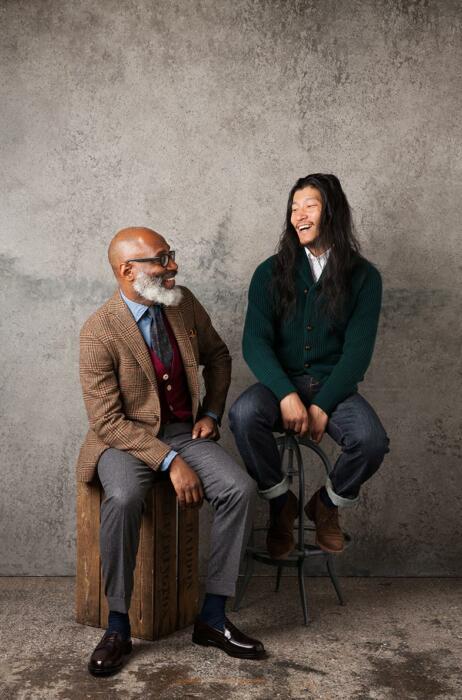

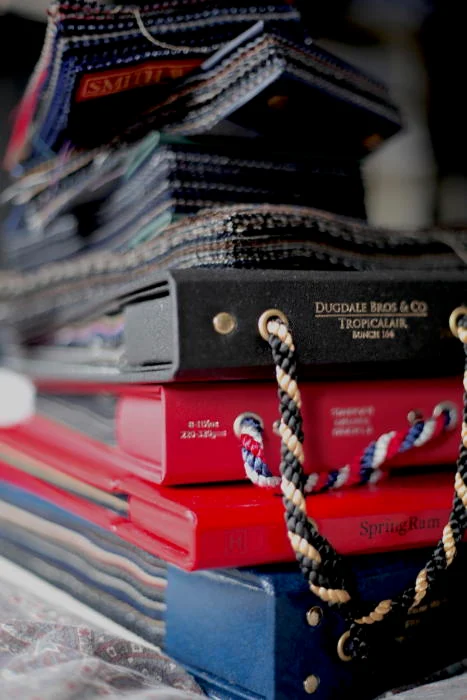
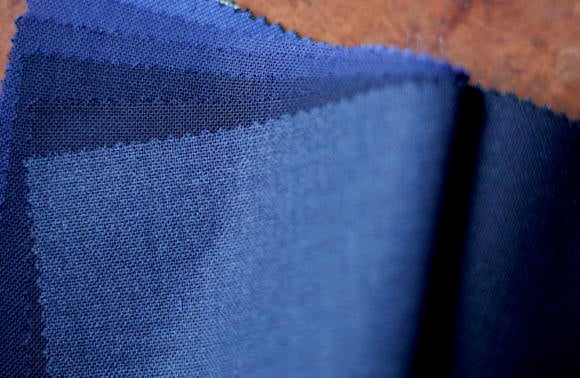
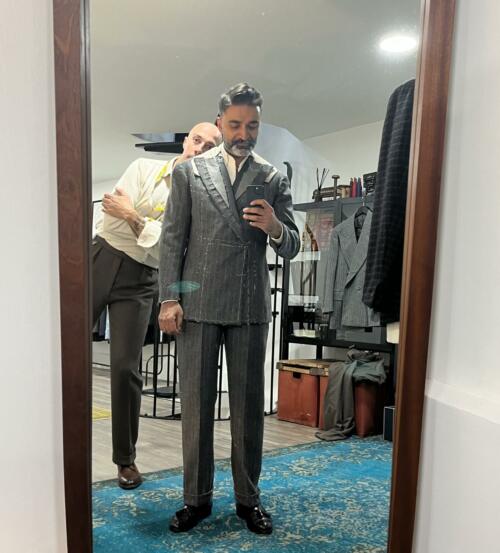
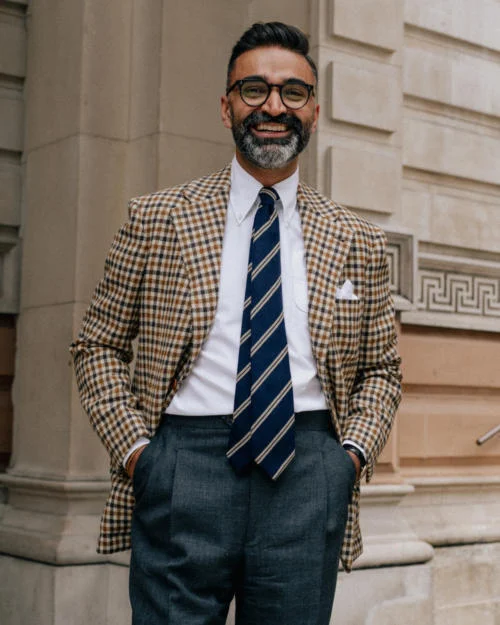
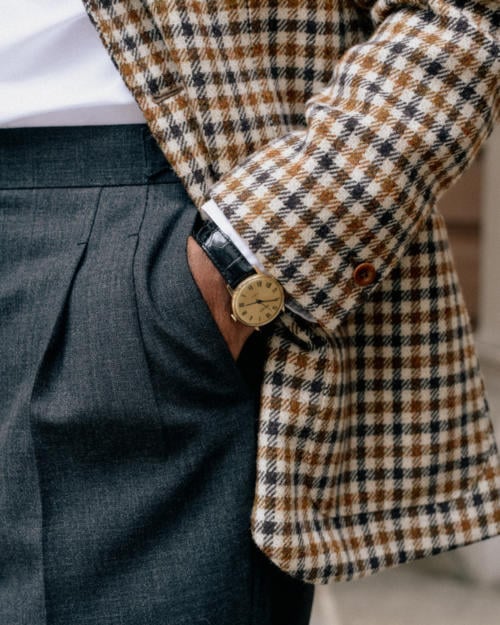
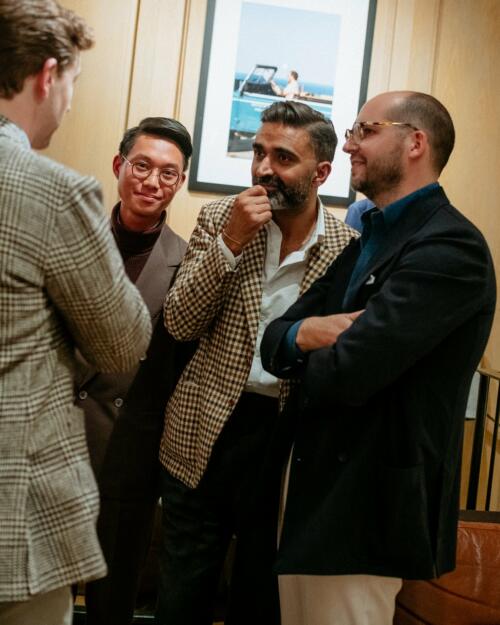





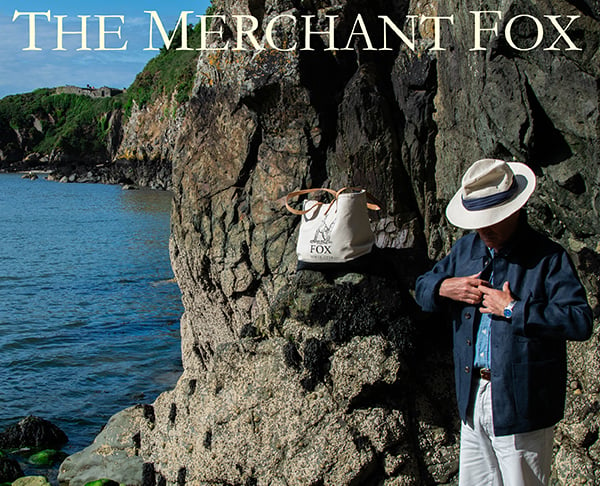






















0 comments